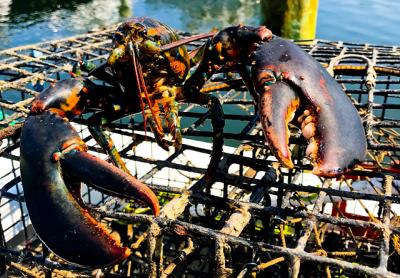Last Call for Lobster

Even though the calendar says it’s September, last Thursday morning dawned hot and incredibly humid. Like many days this summer, it was downright tropical. Despite a 10-knot breeze out of the southwest, beads of sweat had formed on the back of my neck as I started up the diesel engine on my boat. The early morning sun was strong. It definitely felt more like the end of July.
While cooler weather was scheduled to start on Friday, stronger winds out of the northeast were predicted for the next several days. The forecast necessitated retrieving my lobster traps for the season. The older I get, the less excited I am about rough seas.
My gear had been in the water since March and lobster management area 6, the section where I set my traps in the northeastern end of Long Island Sound, was set to close on Saturday and would not reopen until Nov. 26. Given the windy forecast, it was time to call it a season, haul the traps to dry land, and undertake some much-needed repairs.
Steering northeast toward the traps in the strong late-summer sunshine, I had time to reflect on the season on the one-hour run. With the sun off my starboard side, Gardiner’s Bay had a slight chop on it in the following sea. Passing the Finest Kind, a dragger on the tow out of Three Mile Harbor, I noticed my water temperature gauge claimed it was 75 degrees in the middle of the bay. Very warm.
Taking a quick glance at my logbook, I also saw that the water temperature was a brisk 42 degrees when I first put my traps in almost six months earlier. Needless to say, I yearned to relive those chilly days as I took a swig of the warm Gatorade from my supply bag.
Throttling back on the engine as I neared my first trap, I saw that my now-faded and seaweed-encrusted orange buoys were the only ones still in the water. Others, mostly recreational folks, had already pulled out their traps. Noncommercial lobster permit holders can fish up to five traps per person for a nominal yearly $10 fee to the New York State Department of Environmental Conservation. Each license holder can retain six lobsters per day. Given the high price of the tasty crustaceans in the retail market, it’s not a bad deal.
The first six traps I pulled up were blanks, with the exception of a few spider crabs and a female lobster bearing eggs, which was immediately released. Live long and prosper, I say.
A few more eggers came up in the next few traps, and finally a few keepers. Lobster dinner was once again secured. The very last trap pulled contained two beautiful hard-shelled lobsters, a fitting way to end the season. It was now time to head back to port into the stiffening breeze.
All in all, the season was a good one. Due to commitments of work and travel on land, it had been nine years since I had been on the water to set out my traps. It felt really great, and it was also nice to be back on a regular diet of lobster.
As for the fishing scene, both commercial and recreational skippers were keeping a wary eye on several tropical disturbances that were churning in the suddenly active Atlantic basin. Building long-period swells have been hitting the ocean beaches for several days and have thrown a wrench in plans to pursue blue water gamefish far offshore, and to chase some species closer to the beach.
“Everyone is talking about hurricanes right now,” said Harvey Bennett, the veteran owner of the Tackle Shop in Amagansett. “Hey, it’s prime time for them. It’s nothing new. It happens every September.”
The 68-year-old Bennett has witnessed more than his fair share of hurricanes in his life. “It’s been a while since we’ve had a big one come to the East End,” he said. “All I know is don’t underestimate Mother Nature. She can pack a real mean punch. She means business.”
As for fishing, Bennett remarked that fishing for porgies and sea bass has been solid and that a nice slug of striped bass showed up underneath the Montauk Lighthouse when the easterly winds came up. He added that snappers, blowfish, and kingfish are also thick in many locations.
“Depending on how close a hurricane comes to us, it’s bound to mix up the fishing scene for better or worse, depending on the fish.”
“If you chum, they will come,” said Sebastian Gorgone of Mrs. Sam’s Bait and Tackle in East Hampton, referring to adding scent, usually ground up clams or bunker, to the water to entice the abundant kingfish to a baited hook. They are being captured near Sammy’s Beach and other spots on the bayside. “I did some scuba diving the other day and smashed a few slipper shells, and immediately a dozen or so kingfish rushed in to eat the scraps. Some blowfish also showed up too.”
Gorgone also confirmed the run of striped bass at the Point, but hoped that after the passage of the rough weather, false albacore will finally appear on the scene.
“Everyone is waiting on the albies,” he said.
“Action has pretty much remained the same, but who knows what the weather will do to the fishing if we get a close call with any of the storms out there,” said Ken Morse of Tight Lines Tackle in Sag Harbor. “Due to the high surf, action will be minimal for a few days. But there are plenty of weakfish, porgies, and kingfish in the bays.”
We welcome your fishing tips, observations, and photographs at [email protected]. You can find the “On the Water” column on Twitter at @ehstarfishing.
